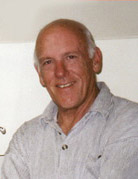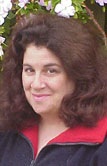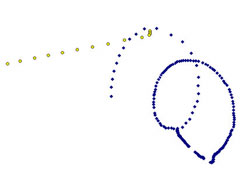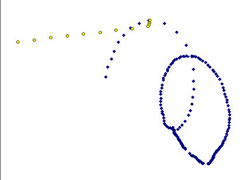May 2005 Article Tennis Server
|

 |
I definitely can not take any credit for this month's column. Colleague Rod Cross is the contributor this month. Rod has collected statistics for the past 10 years from the Australian, French, US Open and Wimbledon. He sent me this very interesting analysis and agreed to share it with the Tennis Server community. Rod's work has been featured in this column before, including Why Cows Hate Natural Gut. Along with Dr. Howard Brody and Crawford Lindsey, he is the author of The Physics and Technology of Tennis (which by the way was the #2 Bestseller on The Tennis Server's Tennis Book and Video Index this past month). Rod and Crawford have another book coming out shortly, titled Technical Tennis: Racquets, Strings, Balls, Courts, Spin, and Bounce.

Rod Cross And now ... GRAND SLAM STATISTICS. A gigantic mountain of statistics is generated each year regarding the Grand Slam events. Those statistics include the earnings of every player, their ranking, height and weight, and a whole bunch of data on serve speeds, serve percentages, number of unforced errors, net approaches, etc. Now that Hawkeye keeps watch on every point, you can even see where every serve lands on the court. Buried in those statistics is some interesting information on the similarities and differences between each Grand Slam event. Each singles event starts off with 128 players and ends up after 127 matches and 2 weeks later with one excessively wealthy winner. Every men's singles event involves about 470 sets, about 4,500 games and about 28,000 hard-earned points. An army of volunteers watches every point, records the details and enters the information on the official web site. Not many people actually take any notice of the statistics of whole events, but consider the following. At Wimbledon, the average first speed for men is 185 km/hr [115 miles/hour]. At the French Open, it is 160 km/hr [100 miles/hour]. How come? At Wimbledon, those 128 men hit about 4,700 unforced errors every year. At the French Open, those same players hit about 16,500 unforced errors every year. How come? Do the players improve out of sight after their practice matches at the French Open? Too much fine French food and wine? At Wimbledon, the men hit 2,500 aces every year. At the French Open they hit only 1,450 aces. At the Australian Open they hit 2,000 aces. At the US Open they hit 2,400 aces. Why the difference at each event? Fewer double faults are hit at the Australian Open than any other Open, only 1,100 in the men's singles, compared with 1,200 at the French Open, 1,370 at the US Open and 1,520 at Wimbledon. How come? If the Australian Open is the first of the season after the Christmas season, and the players are bit out of touch, shouldn't they serve more double faults then? These statistics have been gathered over many years and are not just simple variations from one year to the next or from one tournament to the next. With around 28,000 points played in every men's singles event, there is a certain inevitability about the outcome at each of the four Open events. For example, there are always about 25 five-set matches at every tournament, about 40 four-set matches and about 60 three-set matches, give or take a few. There are always about 470 sets played in men's singles and there are always about 4,500 games. In every men's singles event there will be 6.2 or 6.3 points to a game on average, except at the French Open where there are 6.45 points to a game on average. Players serve one ace every 12 points at Wimbledon and the US Open, one ace every 13.5 points at the Australian Open and one ace every 20 points at the French Open. Double faults occur about once every 25 points at the Australian and French Opens, and about one every 20 points at Wimbledon and the US Open. Statistical events such as an ace or double fault are easy to count. The only other way a point can end is if one player hits a winner or makes an unforced error or a forced error. There is a grey line between each of these outcomes so the people who count these events might themselves make an occasional error. A player who hits a ball that is out of reach of an opponent is said to hit a winner if the ball goes in but if the ball goes out the shot could be an unforced error or a forced error depending on whether it was an easy or difficult shot. The differences in each event are clearly due to the different court surfaces. It's not the players or the balls since the majority of the players are the same at every event and since the weight and size and stiffness and bounce of the balls is specified within very tight limits by the International Tennis Federation. The Australian Open is placed on Rebound Ace, the US Open is played on Deco-turf, the French Open is played on clay and Wimbledon is played on grass. Each surface has a different speed and bounce, meaning that the ball slows down by a different amount on each surface and it bounces to a different height. Grass is the fastest surface and it also has the lowest bounce, at least at Wimbledon where the grass is cut very short. Clay is the slowest surface and it has the highest bounce. Rebound Ace and Deco-turf are both hardcourt surfaces and give more consistent bounces than grass or clay. Both of the hardcourt surfaces have the same bounce but Rebound Ace is usually a bit slower since it has a bit more sand mixed in with the paint applied on top of the rubber base. At Wimbledon, players serve as fast as they can so that the ball keeps low, making it doubly difficult for the receiver to return the ball. The result is that rallies are shorter and players serve more aces and more double faults than at any other Grand Slam event. Clay is a much slower surface since the ball digs into the clay and slows down to about half its speed before it bounced. The ball then has to climb out of the hole it makes and gets deflected upwards by the mound of clay formed at the front of the ball. Players take advantage of the high bounce by serving with a lot of topspin which curves the ball down onto the court at a steeper angle and causes it to bounce up to around shoulder height. The effort needed to apply topspin reduces the serve speed by about 25 km/hr [15.5 miles/hour] compared to the flatter serves at Wimbledon. As a result there are fewer aces and fewer double faults than at Wimbledon. It is harder to hit a winner at the French Open since the ball slows down so much when it bounces. As a result the rallies are generally longer and a player usually wins the point because his or her opponent makes a mistake. That's why there are so many unforced errors at the French Open. At Wimbledon players make mistakes because the ball is coming at them too fast, which counts as a forced rather than an unforced error if they can get their racquet to the ball. If all mistakes were counted as errors then there would still be more errors at the French Open since there are not as many clean winners as at the other Grand Slams. A clean winner means that the opponent can't get the racquet to the ball in time. Tournament organizers like to fiddle with court surfaces to see if they can improve the surface, but without scientific measurements to control the procedure, the result is sometimes unexpected. The recipe at Wimbledon has been refined over more than 100 years. The French have also refined their techniques over many years to produce a top surface of very fine clay almost like talcum powder. It is not actually clay but crushed bricks and tiles that are used. The French don't like to give away their recipe or court speed data in case someone else decides to copy it. In any case, it is unlikely to be copied by anyone since the maintenance costs would be too high for year-round use, the stabilizing ingredients under the surface are not commonly available and since powder turns to mud when it rains. Second Serve Statistics At Wimbledon last year Grosjean beat Gambill in three sets in the third round. Gambill's first serve was working well but his second serve let him down. Gambill served 15 aces, he got 58% of his first serves into play, and he won 79% of his first serves when they went in. The problem was he won only 14 of his 45 second serves. What he should have done was to serve two first serves instead of one first and one second serve. That way he would have got 58% of the 45 second serves or 26 good second serves into play. He would have served 45 - 26 = 19 double faults instead of only 5, but he would have won 79% of those 26 second serves or 21 points instead of only 14. The tactic of serving two first serves works best when the server is winning less than half the second serves and more than 70% of good first serves. There were at least 33 matches and possibly as many as 60 matches at Wimbledon this year where two first serves would have worked better than one first and one second. In past years Sampras often sent down two first serves but he had such a good first serve that he could get away with it. Lesser mortals would also benefit when the occasion arises, but the psychological barrier of sending down so many double faults is probably the major drawback. It is not a tactic for the faint hearted, especially when facing critical break or set points. [Note ... We observed and discussed this "two first serve" behavior in a young Venus Williams at her first US Open in 1997 in Biomechanics In Tennis - Part 3.]
Many thanks to Rod for this very interesting tabulation of Open statistics. This article "Grand Slam Statistics" is copyright 2005 by Rod Cross, all rights reserved. Until Next Month ... Jani
This column is copyrighted by Jani Macari Pallis, Ph.D., all rights
reserved.
Dr. Jani Macari Pallis is the founder and CEO of Cislunar Aerospace,
Inc., an engineering and research firm in San Francisco. In addition
to her engineering practice, she has led two collaborations between
NASA and Cislunar, creating educational materials on the aerodynamics
of sports for pre-college students and educators. As the head of
NASA's "Aerodynamics in Sports" project, she has led a team of
researchers investigating the aerodynamics, physics and biomechanics
of tennis. The group has conducted high speed video data capture at
the US Open and research of ball/court interaction, footwork, serve
speeds, trajectories and ball aerodynamics. Pallis received a BS and
MS from the Georgia Institute of Technology, an MS in mechanical
engineering from the University of California, Berkeley and a Ph.D.
in mechanical and aeronautical engineering from the University of
California, Davis. She is a member of the Executive Committee of The
International Sports Engineering Association.
Questions and comments about these columns can be directed to Jani by
using this form.
|



October 2022 Tennis Anyone: Patterns in Doubles by John Mills. September 2022 Tennis Anyone: Short Court by John Mills. |
 You will join 13,000 other subscribers in receiving news of updates to the Tennis Server along with monthly tennis tips from tennis pro Tom Veneziano.
You will join 13,000 other subscribers in receiving news of updates to the Tennis Server along with monthly tennis tips from tennis pro Tom Veneziano. 

